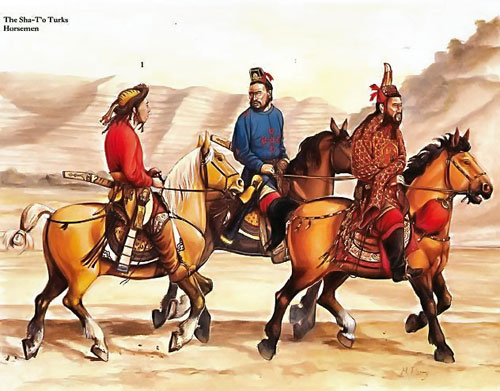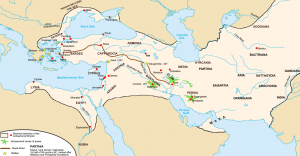Eurasian nomads, recognized for their ability to survive outside centralized civilizations, were able to survive the arid lands of Central Asia by adapting to their ecological surroundings. Unfortunately for them, Central Asia does not receive enough rain to support large-scale agriculture. As a result, with only miles of grasses and shrubs, these steppe lands lack large rivers or ponds of water that might support irrigation systems.
Their nomadic way of life depended on grazing animals that thrived on the grasslands and shrubs of these Central Asian steppes. They would take advantage of these grasslands to herd sheep, horses, cattle, goats, and camels. Nomadic people would drive their herds from one location to another in search of greener pastures. They were keenly aware of their migratory cycle. They took into account the seasons and the local climate, and they lived mostly off their animals: meat, milk, and the hides or fleece of their flocks. In fact, they used animal bones for tools and animal dung as fuel. Clothing and shoes would be made out of wool and skins. No matter what animal it was, there was always a use. Their hides, materials, and even alcoholic beverages all came from the herd of animals.1
Lacking a settled lifestyle, they developed a culture very different from urban societies. The climate was very harsh and with the lifestyle of the nomads, life was rough. As a result, they relied on opportunities to trade with settled people. Much of this trade was on a small scale due to the immediate needs of the nomadic people. However, because of their recognition of the land, they were able to create long-distance trade networks. The mobility and familiarity with large regions of Central Asia were skills that greatly benefited these nomads. These nomads organized and directed caravans across Central Asia linking the settled societies of China with those of the Mediterranean basin.2
Nomadic society was comprised of two social classes: the elites and commoners. Only the strong, charismatic leaders of the group would be recognized as elites. Once at that level, they would organize social clans and tribes. However, elites normally did little governing. The clans typically controlled their own affairs and resented any interference whatsoever. But when it was time for war, the elites took no remorse and put absolute authority over the forces within their alliances.3
Ultimately, this nomadic ‘nobility’ was a flexible social system. Leaders were able to pass elite status along to their heirs, as long as they acted appropriately. If not, they would be stripped from their position and cut short from any leadership role inside the clan. Meanwhile, commoners had the opportunity to become elites. If they exemplified good conduct by being courageous at warfare, they would have the opportunity to become an elite leader.4

As they expanded, nomadic people were able to create enormous military power due to their outstanding cavalry forces. They had superior equestrian skills, with deadly bow and arrow accuracy, capable of taking down anything that comes their way. They coordinated superb movements to outmaneuver their opponents. In fact, few armies were capable of resisting the mobility and discipline of well-organized nomadic warriors. With such military power, several groups of nomadic societies began to conquer the wealth of settled societies and build imperial states in the surrounding areas of Central Asia.5
No matter the setbacks, the Eurasian nomads were capable of surviving harsh conditions, limited water supply, and just about everything that came their way. At the end, they were able to establish successful trading opportunities with settled societies and gain valuable resources, while becoming one of the most feared and successful warriors in Central Asia due to their unmatched skills and mobility.
- Jerry Bentley, Herbert Ziegler, and Heather Streets Salter, Traditions & Encounters: A Brief Global History Volume 1, 4 edition (McGraw-Hill Education, 2015), 256. ↵
- Jerry Bentley, Herbert Ziegler, and Heather Streets Salter, Traditions & Encounters: A Brief Global History Volume 1, 4 edition (McGraw-Hill Education, 2015), 257. ↵
- Encyclopedia Britannica, June 2007, s.v. “The Steppe | Geographical area, Eurasia,” by William H. McNeill. ↵
- Encyclopedia Britannica, December 2015, s.v. “Turkic People,” by Lars Johanson. ↵
- Jerry Bentley, Herbert Ziegler, and Heather Streets Salter, Traditions & Encounters: A Brief Global History Volume 1, 4 edition (McGraw-Hill Education, 2015), 258. ↵



22 comments
Nicolas McKay
It was interesting when you mentioned that nomads were more successful than many other societies living in cities. Before this article I have assumed that a large group of people would are better than a few who are always on the move, but now I can understand how they faced so well. I was also surprised to read that social classes existed even in a small and fluctuating groups such as the nomads. I have to agree with Cameron that a little more background information would work well, but other than that it was a great read.
Cameron Adelman
While the content of your article was interesting and informative, there is some room for improvement.
First, there is some disparity between the title of your article and its content. With a title like “Eurasian Warriors in Central Asia,” you would expect your article’s content to focus primarily on exactly that: the Eurasian warriors of Central Asia as well as their tactics, structure, and war technology. In practice, your article contains more information on the culture and social structure of the Eurasian people, and really only mentions the warriors in the sixth paragraph. I would suggest rewording your title to more accurately reflect the content of your article.
Second, your article could use more context to better allow an uninformed reader to understand who exactly it is your talking about. The term “Eurasian warrior” is fairly vague, given that the Eurasian landmass has collectively contained a wide variety of ethnic groups and cultures throughout the course of history. Admittedly, you do focus the scope of your article to nomads located in Central Asia, but you could still benefit from further clarification. One way to do this would be to explain who you are talking about using modern points of reference (i.e. These nomadic tribes roamed a wide territory, which ranged from modern day Russia to Saudi Arabia).
Finally, it would be helpful if your article identified what time period you were discussing, as this information is absent from the article.